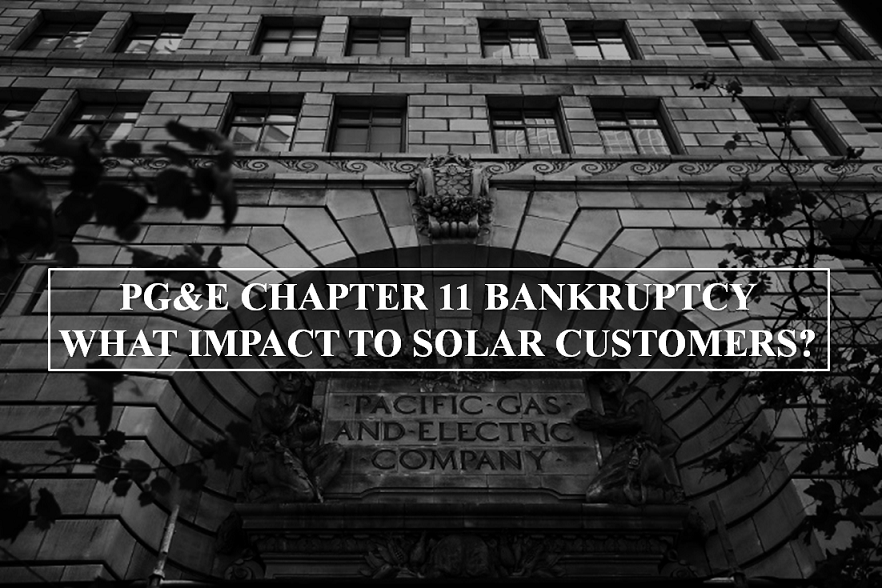Cenergy Alert: PG&E’s Bankruptcy- What impact on Solar Customers?

Cenergy Alert: PG&E’s Bankruptcy - What impact on Solar Customers?
On January 29, 2019, PG&E filed for Chapter 11 bankruptcy protection. As California’s largest utility with about 16 million natural gas and electricity customers, PG&E will be able to leverage the Chapter 11 filing to keep operating while it works out a comprehensive plan to address its wildfire liabilities and onerous long-term power contracts.
Indeed, PG&E’s orderly reorganization will be complex and is likely to take 2-3 years to sort out. There is a litany of intertwined regulatory, political and contractual considerations for PG&E’s stakeholders, contract counter-parties and customers, and no one is expected to be happy with the compromises that will be required to keep the lights on at the massive utility.
In this alert, we provide some context to PG&E’s bankruptcy filing and explain why it is likely to have little impact for customers that have gone or will go solar.
Why did PG&E file for Bankruptcy?
On its website, PG&E states that it “believe[s] that the Chapter 11 process will facilitate the orderly, fair and expeditious resolution of the liabilities that have arisen and will continue to arise in connection with the 2017 and 2018 Northern California wildfires.”
According to the California Department of Forestry and Fire Protection, PG&E equipment may have caused at least 17 major California wildfires since 2017. PG&E has been cited for various safety violations in the aftermath of the fires and has been ordered to re-inspect its entire power grid for hazards. The state’s inverse condemnation law, as it stands, would hold PG&E responsible for wildfire damage caused by its equipment, whether it acted negligently or not.
As a result, PG&E says it is facing up to $30 billion in potential wildfire liabilities, and credit rating agencies Moody’s and S&P have downgraded the utility’s +$17 billion in outstanding bonds to junk status. PG&E is also expected to leverage the bankruptcy process to renegotiate unattractive long-term energy contracts with large suppliers like NextEra in an effort to lighten its non-core obligations going forward.
On a macro level, California’s Public Utilities Commission (CPUC) and lawmakers will likely consider alternative reforms that could break up PG&E, turn it into a government‐ run operation (at least temporarily) or de-regulate inefficient aspects of its business. After all, this is PG&E’s second bankruptcy filing in less than 20 years.
What Impact does PG&E’s Bankruptcy have on Solar Customers?
PG&E’s solar customers should be relieved that the utility has secured a commitment for $5.5 billion in debtor-in-possession financing from large lenders to provide it with "sufficient liquidity to fund its ongoing operations.” As PG&E details in its bankruptcy filing, this would include “programs supporting customer adoption of clean energy.”
While PG&E is expected to push for renegotiations of large wholesale power purchase agreements with energy giants like NextEra (e.g., PG&E has already asked the bankruptcy judge to rule that the court has the exclusive right to reject existing power purchase agreements), there are two primary reasons behind PG&E’s affirmative statement that it will continue to administer clean energy programs like Net-Energy Metering (NEM) and Renewable Energy Self-Generation Bill Credit Transfer (RES-BCT).
First, such renewable programs were mandated by state law, and it would be next to impossible to unwind such mandates, especially since they benefit millions of California power consumers. Second, PG&E (like other investor owned utilities in California) is guaranteed negotiated returns on equity (ROE) and rate base that factor in the increased enrollment in the State’s clean energy programs like net metering. Specifically, the CPUC set PG&E’s guaranteed returns at a healthy 10.4% (for ROE) and 8.04% (for rate base) during its 2017 rate case--- net of the utility’s net metering costs.
If anything, PG&E customers that have not gone solar can generally expect to see rising electricity costs in the coming years as they are the utility’s main source of funding to recoup losses from the fires. In its 2020 General Rate Case (GRC) proposal (submitted to the CPUC in December 2018 prior to its bankruptcy filing), PG&E requested a $1.058 billion increase over currently authorized spending for 2019 (half of which would be directly related to wildfire prevention and safety enhancements).
PG&E further stated that, “while the GRC proposal will help fund a series of important safety investments, this proposal does not request funding for potential claims resulting from the devastating 2017 and 2018 Northern California wildfires, the largest of which are still under investigation.” The subtle message here is that depending on how PG&E’s financial situation looks post- fire lawsuits, PG&E may need to request further rate increases to remain sustainable.
For more information on how PG&E’s bankruptcy may impact your specific project, please contact Nader Yarpezeshkan at nader@cenergypower.com.

